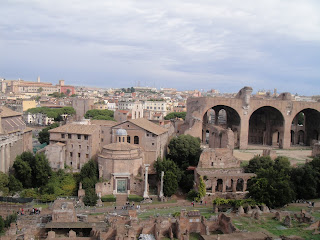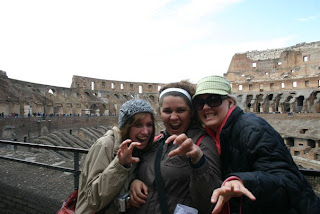Foro e Palatino Biglietto-
The Roman Forum (Latin: Forum Romanum), sometimes known by its original Latin name, is located between the Palatine hill and the Capitoline hill of the city of Rome. It is the central area around which the ancient Roman civilization developed. Citizens referred to the location as the "Forum Magnum" or just the "Forum".
The oldest and most important structures of the ancient city are located in the forum, including its ancient former royal residency, the Regia, and the surrounding complex of the Vestal virgins. The Old Republic had its formal Comitium there where the senate, as well as Republican government began. The forum served as a city square and central hub where the people of Rome gathered for justice, and faith. The forum was also the economic hub of the city and considered to be the center of the Republic and Empire.
Palatine Hill in Imperial Rome of the famous seven hills of Rome. Located in between such attractions as the Circus Maximus, the Colosseum, and the Roman Forum, evidence from archaeological digs demonstrates that the hill was inhabited as long ago as the 10th century BC.
The hill has a strong link to Roman mythology. It is believed that on Palatine Hill, the twins Romulus and Remus were found in the Lupercal Cave by their four-legged shepherd mother, who raised them. Ultimately, this is where Romulus decided to build the city.
The Palatine Hill todayTherefore, it was on this hill that the Roman Empire began.




The Roman Forum (Latin: Forum Romanum), sometimes known by its original Latin name, is located between the Palatine hill and the Capitoline hill of the city of Rome. It is the central area around which the ancient Roman civilization developed. Citizens referred to the location as the "Forum Magnum" or just the "Forum".
The oldest and most important structures of the ancient city are located in the forum, including its ancient former royal residency, the Regia, and the surrounding complex of the Vestal virgins. The Old Republic had its formal Comitium there where the senate, as well as Republican government began. The forum served as a city square and central hub where the people of Rome gathered for justice, and faith. The forum was also the economic hub of the city and considered to be the center of the Republic and Empire.
Palatine Hill in Imperial Rome of the famous seven hills of Rome. Located in between such attractions as the Circus Maximus, the Colosseum, and the Roman Forum, evidence from archaeological digs demonstrates that the hill was inhabited as long ago as the 10th century BC.
The hill has a strong link to Roman mythology. It is believed that on Palatine Hill, the twins Romulus and Remus were found in the Lupercal Cave by their four-legged shepherd mother, who raised them. Ultimately, this is where Romulus decided to build the city.
The Palatine Hill todayTherefore, it was on this hill that the Roman Empire began.














The Colosseum or Roman Coliseum, originally the Flavian Amphitheatre (Latin: Amphitheatrum Flavium, Italian Anfiteatro Flavio or Colosseo), is an elliptical amphitheatre in the center of the city of Rome, Italy, the largest ever built in the Roman Empire. It is one of the greatest works of Roman architecture and Roman engineering.Occupying a site just east of the Roman Forum, its construction started between 70 and 72 AD[1] under the emperor Vespasian and was completed in 80 AD under Titus[2], with further modifications being made during Domitian's reign (81–96).[3] The name "Amphitheatrum Flavium" derives from both Vespasian's and Titus's family name (Flavius, from the gens Flavia).
Capable of seating 50,000 spectators,[1][4][5] the Colosseum was used for gladiatorial contests and public spectacles. As well as the gladiatorial games, other public spectacles were held there, such as mock sea battles, animal hunts, executions, re-enactments of famous battles, and dramas based on Classical mythology.


Rosie, Me, Gwenith, Chelsea, Amanda, Micheal and Toby - infront of the Colosseum




The Pantheon (pronounced /pænˈθiː.ən/ or /ˈpænθi.ən/,[1] Latin: Pantheon,[nb 1] from Greek: Πάνθεον, meaning "Every god") is a building in Rome, originally built by Marcus Agrippa as a temple to all the gods of Ancient Rome, and rebuilt in the early 2nd century AD. The building is circular with a portico of three ranks of huge granite Corinthian columns (eight in the first rank and two groups of four behind) under a pediment opening into the rotunda, under a coffered, concrete dome, with a central opening (oculus) open to the sky. Almost two thousand years after it was built, the Pantheon's dome is still the world's largest unreinforced concrete dome[citation needed]. The height to the oculus and the diameter of the interior circle are the same, 43.3 metres (142 ft).[3] A rectangular structure links the portico with the rotunda. It is one of the best preserved of all Roman buildings. It has been in continuous use throughout its history, and since the 7th century, the Pantheon has been used as a Roman Catholic church dedicated to "St. Mary and the Martyrs" but informally known as "Santa Maria Rotonda."[4]






The Contarelli Chapel, within the church of San Luigi dei Francesi in Rome, is famous for housing three paintings on the theme of Saint Matthew the Evangelist by the Baroque master Caravaggio.Caravaggio's solution to decorating a typically gloomy Roman church interior was revolutionary and brilliant. Visitors to the Contarelli Chapel today are confronted with paintings that use the gloom instead of fighting against it. The paintings themselves are dark - mostly shadow - one can surmise that perhaps the opportunity to use large amounts of shadow freed the artist to meet his pressing deadline - but certainly there has been a gain in drama, as the highlighted figures of saints and executioners leap out of the enveloping dark. Caravaggio also considered the lighting in the chapel: each of the two side paintings is lit by a beam of light coming from the same direction as the natural lighting in the chapel itself.
The Calling of Saint Matthew, Caravaggio, 1599-1600
The Martyrdom of Saint Matthew, Caravaggio, 1599-1600
The Inspiration of Saint Matthew, Caravaggio, 1599-1600
The Martyrdom of Saint Matthew, Caravaggio, 1599-1600
The Inspiration of Saint Matthew, Caravaggio, 1599-1600













No comments:
Post a Comment